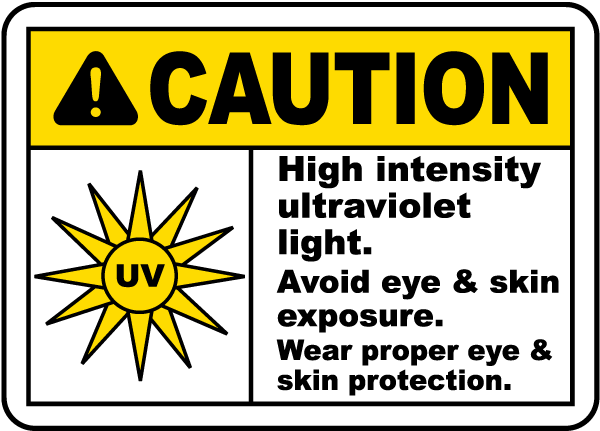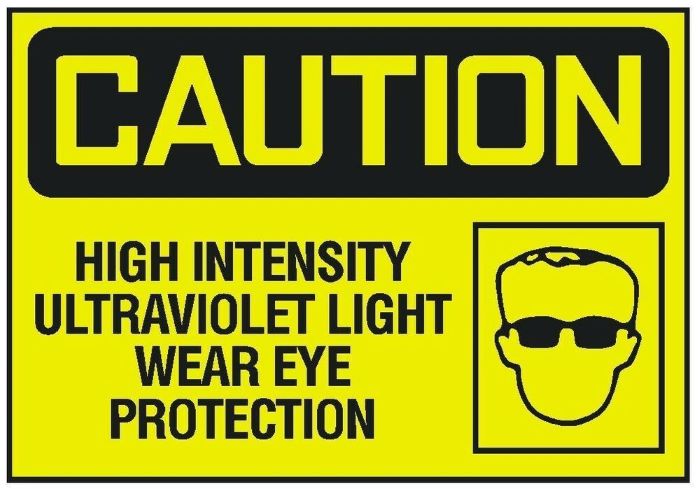LUYOR-3109高强度紫外催化光源促销
LUYOR-3109紫外光源采用了9颗365nm大功率led,安装有二次光学透镜,输出紫外线强度高,...
2024-08-08作者:紫外光源事业部时间:2019-12-16 21:06:21浏览11722 次
如果不正确地使用紫外线灯,可能会导致严重的痛苦的眼和皮肤伤害,因此,只有熟悉潜在危险和控制措施的经过授权和培训的人员才能使用此类设备。 紫外线灯必须在难以进入的指定区域内使用,以保护路人。 在密闭,通风良好的房间或悬垂的区域内操作可降低暴露的风险.
紫外线灯安全说明书
ULTRAVIOLET LAMP SAFETY FACTSHEET
紫外线(UV)灯用于各种应用中。它们分别有杀菌灯,“黑光灯,汞蒸气灯,太阳能模拟器,光化学固化设备,金属卤化物灯等。电磁光谱的紫外线辐射部分的波长大约在100nm至400nm之间。 [注:1 nm =1纳米=一米的十分之一。] UV光谱已细分为三个不同的光谱带:
LUYOR ultraviolet (UV) lamps are used on the UC Irvine campus in a variety of applications. They are found in germicidal lamps, “black lights”, mercury vapor lamps, solar simulators, photochemical curing equipment, metal halide lamps, etc. the UV radiation portion of the electromagnetic spectrum lies approximately between 100 nm and 400 nm in wavelength. [Note: 1 nm = 1 nanometer = one billionth of a meter.] The UV spectrum has been subdivided into three distinct spectral bands:
UV-A辐射(315nm至400nm),被称为“近UV”和“黑光”,具有更低的生物活性,但暴露会导致皮肤晒黑和灼伤皮肤,并导致白内障的形成(眼晶状体中的不透明性)。它可以通过空气和普通玻璃有效地传播。 [晒黑店通常将顾客暴露在UV-A辐射下。]
UV-B辐射(280nm至315nm)被称为“中B波UV”和“红斑UV”,引起皮肤晒黑和“晒伤”,光性角膜炎(眼角膜发炎),光结膜炎(角膜炎)。粘在眼睑内表面的粘液膜和白内障。它是通过空气传播的,但可以用普通玻璃阻挡。
被称为“远紫外线”和“杀菌紫外线”的UV-C辐射(100nm至280nm)也会引起光性角膜炎和光结膜炎,在270nm处产生更大作用。它被普通玻璃和空气(波长<200nm)阻挡。
由于症状的隐匿性发作,暴露的人通常直到损害发生时才意识到暴露于紫外线辐射的危害(最初没有疼痛感)。例如,在海滩上被晒伤的人常常不理解自己的困境,直到他们回家并冲凉!
UV-A radiation (315 nm to 400 nm), which is called “near UV” and "black light", is the least photobiologically-active, but exposure can produce tanning and some burning of the skin, and can lead to the formation of cataracts (opacities in the lens of the eye). It is efficiently transmitted by air and common glass. [Tanning parlors generally expose patrons to UV-A radiation.]
UV-B radiation (280 nm to 315 nm), which is called “middle UV” and "erythemal UV", causes skin tanning and “sunburn”, photokeratitis (inflammation of the cornea of the eye),photoconjuctivitis (inflammation of the mucus membrane which lines the inner surface of the eyelids), and cataracts. It is transmitted by air, but can be blocked with common glass.
UV-C radiation (100 nm to 280 nm), which is called “far UV” and "germicidal UV", also causes photokeratitis and photoconjunctivitis, with maximum effects occurring at 270 nm. It is blocked by common glass and by air (for wavelengths < 200 nm).
Due to the insidious onset of symptoms, exposed persons often do not realize the hazard attendant to exposure to UV radiation until the damage has occurred (sensations of pain do not occur initially). For example, persons who get sunburned at the beach often do not comprehend their predicament until they arrive home and get into the shower!
除了对眼睛和皮肤造成严重危害外,空气(和空气中的物质)的紫外线辐射还会导致有毒化合物的产生,附近的人员可能会接触到这些化合物。波长低于250nm的紫外线辐射会产生臭氧和氮氧化物,并将氯代烃(如果存在)转化为光气和氯化氢。在某些情况下,暴露于有毒气体的风险比暴露于紫外线辐射本身的风险要大得多,这是因为在紫外线发生系统中加入了光学防护装置,并且紫外线区域没有足够的通风资源。
In addition to presenting significant eye and skin hazards, UV irradiation of the air (and of airborne substances) can lead to the generation of toxic compounds to which nearby personnel can be exposed. UV radiation at wavelengths below 250 nm can produce ozone and nitrogen oxides, and can convert chlorinated hydrocarbons, if present, into phosgene and hydrogen chloride. In some instances, the risks from exposure to toxic gases are more substantial than the risks from exposure to the UV radiation itself, due to the incorporation of optical safeguards into the UV generating system, and the absence of adequate ventilation in the area of the UV source.
紫外线灯安全准则Ultraviolet lamp safety guidelines
校园中的主要研究人员(PI)必须确保将在其监督下使用紫外线源的个人接受与这些源相关的危害以及使用该设备的安全方法的充分培训。在要使用UV-B和UV-C光源的情况下尤其如此。当认为必要和适当时,PI必须向所有可能暴露的员工提供保护设备。
Principal Investigators (PIs) on campus must ensure that individuals who will be using UV sources under their supervision are adequately trained in the hazards related to these sources, and in the safe methods of using the equipment. This is especially true in cases in which UV-B and UV-C sources are to be used. PIs must supply protective equipment to all potentially exposed staff members when such equipment is deemed necessary and appropriate.
仔细研究所使用的紫外线发生设备制造商提供的手册,并且在未事先联系制造商的情况下,请勿偏离有关其安全操作的说明。这些手册提供了与安全相关的特定信息(例如,所需的眼睛/皮肤防护类型,通风要求等),在给设备通电之前必须完全理解这些信息。如果对使用紫外线发生设备的安全性有任何混淆,请务必与LUYOR联系以澄清您可能遇到的任何问题。如果您仍然不确定这些问题,请致电4006-254-365与LUYOR联系。
Carefully study the manuals supplied by the manufacturer of the UV-generating equipment used, and do not deviate from the instructions concerning its safe operation without first contacting the manufacturer. These manuals provide specific safety-related information (such as the type of eye/skin protection needed, ventilation requirements, etc.) that must be completely understood prior to energizing the equipment. If there is any confusion at all regarding the safe use of UV-generating equipment, it is essential that LUYOR be contacted to clarify any concerns that you might have. If you are still uncertain about these issues, contact LUYOR at 4006-254-365.
如果不正确地使用紫外线灯,可能会导致严重的痛苦的眼和皮肤伤害,因此,只有熟悉潜在危险和控制措施的经过授权和培训的人员才能使用此类设备。 紫外线灯必须在难以进入的指定区域内使用,以保护路人。 在密闭,通风良好的房间或悬垂的区域内操作可降低暴露的风险.
Serious and painful eye and skin injuries can result if UV lamps are used improperly.Therefore, only authorized and trained personnel familiar with the potential hazards and control measures may use such units. UV lamps must be used in designated areas with limited access,which affords protection to passers-by. Operation from within a closed, well-ventilated room or a draped area reduces the risks of exposure.

紫外线警告标志
尽可能在完全封闭,互锁的条件下使用紫外线灯。除非有良好的控制危险,否则不得故意破坏互锁!即使遮盖了眼睛和皮肤,也应避免不必要的曝光。 切勿直接观看紫外线灯。 采取所有必要的步骤将暴露时间减少到合理可及的短的时间,并使用屏障/外壳/遮罩以发挥更大作用。
Whenever possible, UV lamps should be used under totally enclosed, interlocked conditions.Interlocks must not be intentionally defeated unless the attendant hazards are otherwise well controlled! Needless exposures should be avoided, even in cases in which the eyes and skin are covered. The UV lamp should never be viewed directly. Take all necessary steps to reduce the exposure time to as short as is reasonably achievable, and use barriers/enclosures/shields to their maximum advantage.
尽管平方反比定律适用于非激光束紫外线辐射,但无论您与紫外线源之间的距离如何,都建议不要直视任何紫外线源(例如电弧或灯)。由于维护和清洁人员在工作期间可能会意外地暴露于紫外线灯的辐射下,因此必须对所有紫外线源和设施进行充分标识,以指示此类人员暴露的危险(在某些情况下, 警告应同时使用英文和西班牙文;危险-紫外线辐射Peligro--RadiaciónUltravioleta)。 理想情况下,所有激活的紫外线源都应由有经验的人员始终陪伴,或将灯置于防呆,联锁的外壳中。 但是,在两种情况下都需要警告标志。 突出的激活警告灯也很有帮助。
Although the inverse square law applies to non-laser beam UV radiation, it is not advisable to look directly at any UV source (such as an arc or lamp) regardless of your distance from it. Since maintenance and janitorial personnel may be accidentally exposed to the radiation from UV lamps while in the course of their duties, it is essential that all UV sources and facilities be adequately labeled to instruct such personnel of the danger of exposure (in some cases, these warnings should be in both English and Spanish; Danger – Ultraviolet Radiation Peligro --Radiación Ultravioleta). Ideally, all activated UV sources should either be attended by knowledgeable personnel at all times, or the lamps should be housed in foolproof, interlocked enclosures. However, warning signs are needed in both cases. Prominent activation warning lights are also helpful.
防护眼镜,防护服和紫外隔离霜
产生紫外线的设备的操作人员必须完全屏蔽紫外线,并屏蔽紫外线,该操作人员必须佩戴紫外线过滤的面罩,长袖衬衫,手套,有时还需要长裤,否则辐射不会完全封闭。 尽管这些物品可能无法完全消除暴露于紫外线辐射的危险,但它们可以大大降低严重烧伤的风险。 如果认为辐射强度不足以引起皮肤影响,则带侧罩的紫外线过滤玻璃偶尔足以满足短期暴露的需要。 但是,这可能是冒险的。 大多数可过滤紫外线的面罩和眼镜由聚碳酸酯塑料制成,能够吸收99%的紫外线至400 nm(紫光)。
Protective Eyewear, Clothing and Skin-protective Agents
Operators of UV-generating equipment for which the radiation is not totally enclosed and exposures are possible must wear UV-filtering face shields, long-sleeved shirts, gloves, and sometimes long pants. Although these items may not completely eliminate the exposure to UV radiation, they reduce the risk of a severe burn substantially. UV-filtering glasses with side shields will occasionally suffice for very short-term exposures when the radiation is not considered to be of sufficient intensity to cause skin effects; this can be a risky venture, though. Most UV-filtering face shields and spectacles are made of polycarbonate plastic, which is capable of absorbing 99% of UV radiation up to 400 nm (violet light).

紫外防护警告标志
对于焊接操作产生的紫外线辐射,保护眼睛的最有效控制方法是使用装有深色的紫外线过滤镜片的合适焊接头盔。同样,必须穿着适当的衣服和手套来保护皮肤(见下文)。可以使用物理上阻挡紫外线辐射的焊接帘/屏保护附近的人员。焊接棚必须充分通风,以保护焊工(和其他人员)免受在焊接和切割操作过程中可能释放出的任何潜在有害烟气,蒸气和气体的伤害。可以穿着适当的衣服(方法!)或使用防护性的乳膏和药膏来保护皮肤。某些类型的织物可以很好地衰减UV辐射,而其他类型的则不能。皮革手套,围裙和夹克已经成功用于焊接,制造和涉及紫外线的研究应用。机织织物的衰减特性差异很大。显然,松散的织物在紧紧抓住灯时可以很容易地看到光,这种效果不如紧密的织物有效。棉织物的UV-B漫透射值通常在5%到30%的范围内,人造丝和人造丝混纺的透射率略低(10%到15%),而厚重的羊毛和法兰绒材料的透射率可能在1%或更小。据报道,府绸具有非常低的紫外线透射率。尼龙效果很差,最多可以透射40%的紫外线。穿多层衣服可以大大提高衰减效果。
For UV radiation generated from welding operations, the most effective control for protecting the eyes is the use of a proper welding helmet containing darkened UV-filtering lenses. The skin must similarly be protected by the wearing of appropriate clothing and gloves (see below). Nearby personnel can be protected by using welding curtains/screens that physically block the UV radiation. Welding booths must be adequately ventilated to protect the welder (and others) from any potentially hazardous fumes, vapors and gases that may be released during welding and cutting operations. The skin can be protected either by wearing appropriate clothing (the preferred method!) or by applying protective creams and ointments. Certain types of fabrics attenuate UV radiation well,while other types do not. Leather gloves, aprons and jackets have been successfully used for this purpose in welding, manufacturing and research applications involving UV exposure. Woven fabrics vary greatly in their attenuation properties. Obviously, loosely-woven fabrics through which one can readily see light when they are held up to a lamp will not be as effective as tightly-woven materials. Cotton fabrics generally have UV-B diffuse transmission values ranging from 5% to 30%, rayon and rayon blends transmit somewhat less (10% to 15%), and heavy wool and flannel materials may transmit 1% or less. Poplin has been reported to have very low UV transmittance. Nylon is very ineffective and may transmit up to 40% of the UV radiation. The attenuation can be greatly enhanced by the wearing of layered clothing.
已经开发了许多局部皮肤保护剂,它们可部分或全部过滤紫外线。 这些试剂包括对氨基苯甲酸(PABA)及其酯,水杨酸酯和氨基甲酸酯。 这些制剂通常与具有良好直接性的物质一起放入溶液中。 亲和性是用于表示溶液对皮肤吸收和保留的亲和性的术语。
A number of topical skin-protective agents have been developed which provide partial to total filtration of UV radiation. These agents include para-aminobenzoic acid (PABA) and its esters, salicylates and cyanamates. These preparations are generally placed into solution with substances that have good substantivity. Substantivity is a term used to indicate the affinity of a solution for absorption into and retention in the skin.
紫外线暴露标准UV Exposure Standards
没有联邦或加利福尼亚州的安全标准规定允许的紫外线职业暴露水平。 在大多数情况下,“一般职责条款”涵盖了紫外线照射,这表明必须保护所有工人免受公认的危害。
There are no Federal or State of California safety standards that specify permissible occupational exposure levels to UV radiation. For the most part, UV exposures are covered under the “General Duty Clause” that indicates that all workers must be protected from recognized hazards.
但是,美国政府工业卫生专家会议确定了紫外线暴露水平(称为“阈值极限值”),据信几乎所有健康工人都可以反复暴露而不遭受红斑(晒伤)或光结膜炎。
TLV适用于电弧,气体和蒸气放电,荧光和白炽光源以及太阳辐射对皮肤的暴露。 {它们不适用于暴露于激光产生的相干UV辐射,也不适用于极度光敏的个体。} TLV旨在用作控制人员暴露于连续UV源(暴露时间> 0.1秒)的准则。 。
TLV以每平方厘米表面积(mJ / cm2)的能量毫焦耳为单位提供。对于需要依赖于波长的曝光时间(需要使用称为相对光谱辐照度的参数)进行计算,它们是180 nm至400 nm波长的函数。 TLV值指示以下内容:
However, the American Conference of Governmental Industrial Hygienists has established UV exposure levels (called Threshold Limit Values) to which it is believed that nearly all healthy workers may be exposed repeatedly without suffering erythema (sunburn) or photoconjunctivitis.
The TLVs apply to exposures of the skin from arcs, gas and vapor discharges, fluorescent and incandescent light sources, and also solar radiation. {They do not apply to exposure to coherent UV radiation generated by lasers, nor do they apply to extremely photosensitive individuals.} The TLVs are intended to be used as guidelines for controlling exposures of personnel to continuous UV sources (exposure duration > 0.1 sec).
The TLVs are provided in units of millijoules of energy per square centimeter of surface area(mJ/cm2). They are presented as a function of wavelength from 180 nm up to 400 nm for wavelength-dependent exposure times that need to be calculated using a parameter termedthe relative spectral irradiance. The TLV values indicate the following:
最危险的紫外线是波长在240 nm至300nm之间的紫外线。 在此波长范围内,TLV小于10 mJ / cm2,最小TLV(最危险的辐射)为270 nm(TLV = 3 mJ / cm2)
危害最小的紫外线是波长超过315 nm的紫外线(UV-A辐射)。 在该波长以上,TLV始终超过1000 mJ / cm2,并且稳步攀升至该波长之上,表明随着波长的增加,辐射的危害性降低。180在180 nm和240 nm之间,辐射变得越来越危险.
The most hazardous UV radiation is that with wavelengths between 240 nm and 300nm. In this wavelength range, the TLV is less than 10 mJ/cm2, with the minimumTLV (the most hazardous radiation) being at 270 nm (TLV = 3 mJ/cm2).The least hazardous UV radiation is that with wavelengths exceeding about 315 nm(UV-A radiation). Above that wavelength, the TLV is always over 1000 mJ/cm2, andit steadily climbs above that wavelength indicating that the radiation is less hazardouswith increasing wavelength.Between 180 nm and 240 nm, the radiation becomes increasingly more hazardous.
从2003 TLV手册中获得的一些附加说明:
1)暴露于紫外线下患上皮肤癌的可能性与多种因素有关,例如皮肤色素沉着(皮肤光亮的人处于更大风险),有灼伤的晒斑史以及终生累积的紫外线剂量。
2)一些局部制剂和内用化学药品会增加暴露于紫外线辐射的风险。 这些例子包括一些抗生素(例如四环素和强力霉素),以及一些抗抑郁药,利尿剂,化妆品,抗精神病药,染料等。请始终意识到这种可能性,并阅读处方/产品标签或就此咨询您的药剂师 物。
3)在夏季,中午大约5分钟之内,赤道40度以内的纬度下的户外工作人员可能会受到超过TLV的紫外线辐射!!!!
A few additional notes obtained from the 2003 TLV booklet:
1) The probability of developing skin cancer from UV exposure is related to a variety of factors such as skin pigmentation (persons with light skin are at the greatest risk), a history of blistering sunburns, and lifetime accumulated UV dose.
2) Some topical preparations and systemic chemicals can heighten the risk of exposure to UV radiation. Examples of these are some antibiotics (e.g., tetracycline and doxycycline), as well as some antidepressants, diuretics, cosmetics, antipsychotic drugs, dyes, etc. Always be cognizant of this possibility and read prescription/product labels or consult with your pharmacist regarding this matter.
3) Outdoor workers in latitudes within 40 degrees of the equator can be exposed to quantities of UV radiation which exceed the TLV in as little as 5 minutes around noon during the summer months!!!